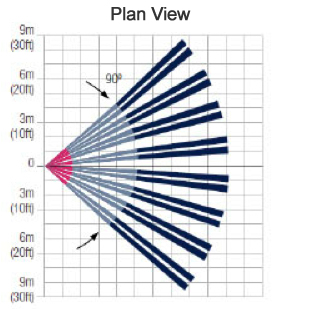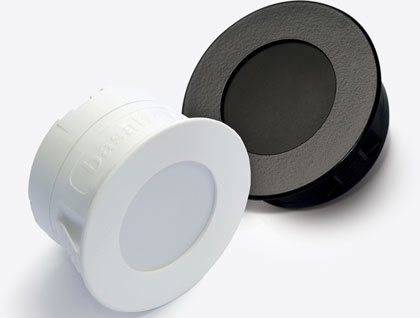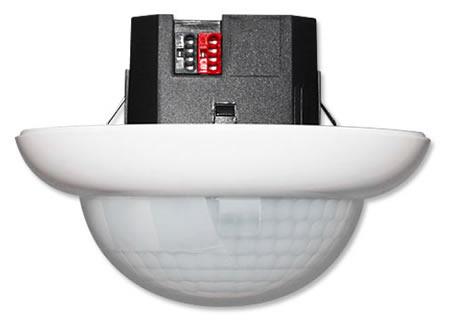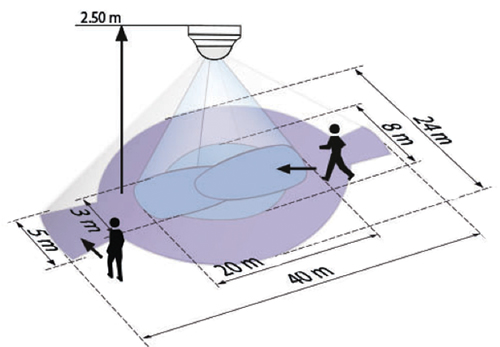 By Simon Buddle, Future Ready Homes.
By Simon Buddle, Future Ready Homes.
Motion detection is perceived by many as a relatively simple function to enable us to trigger fans or lights, whether internal or external. It’s not very clever and doesn’t require much by way of code to make it work. There are, however, myriad detector types utilising a wide array of technologies, and I’ve seen many an installation where the PIR has been chosen for its aesthetic qualities rather than its technical capabilities.
Which types of technology and how they are applied can make the difference between a customer waving their arms about frantically every two minutes from their shower or hotel corridor in order to prevent things from going dark prematurely, and a space being perfectly lit for the desired function.
The Technology
• Passive infrared (PIR) – PIR sensors are sensitive to a person’s skin temperature in contrast to background objects that are at room temperature. No energy is emitted from the sensor, hence the term ‘passive’ infrared. The device can be affected by direct sunlight and cannot ‘see’ through walls or see curtains moving.
• Microwave – this type of sensor detects motion through the principle of the Doppler Effect. A microwave motion detector comprises the transmitter, the receiver and the alarm/related circuit. The transmitter sends off microwaves into the area. These waves have a specific frequency. However, as they strike someone moving, the phase of the wave signal is altered. Once these reflected waves are received by the receiver, phase analysis is done and consequently, an alarm is triggered if the analysis detects a change in the phase of the wave signals. It may be possible for the device to be triggered through thin walls comprising perhaps one skin of plasterboard each side without foil backing, and it doesn’t see stationary people. It could be triggered by moving curtains.
• Ultrasonic – an ultrasonic wave (sound at a frequency higher than a human ear can hear) is emitted and reflections from nearby objects are received. Again, using the Doppler Effect, the device can analyse movement.
One potential drawback of ultrasonic sensors is that they can be sensitive to motion in areas where coverage isn’t desired, for instance, due to reflections of sound waves around corners. Whilst such extended coverage may be desirable for lighting control, if the point is detection of any occupancy in an area, for other applications, such as opening an automatic door, one would prefer a sensor that is selective to traffic in the path toward the door.
• The Fresnel Lens – this lens is used in lighthouses and in PIRs. In a lighthouse, the concentric annular sections focus the light source to create a beam or shaft of light that is then spun to create a moving shaft of light to warn shipping.
In a PIR, the lens is effectively inverted to create a much wider beam than the detector is capable of. The lens also focuses the returning IR onto the receiving sensor. As the beams get further from the PIR, so the space between them grows. Because of this effect, it is possible to walk between the beams and get quite close to a detector before it activates. It is also true for height, the higher the detector is placed the wider apart the beams will be.

• Dual-tech
The clue is in the name. This is a PIR that uses two types of technology to detect.
• Occupancy Detection or Automatic – a PIR that has been set to turn the lights on when triggered by movement, and off after a time-defined period of no movement or activity.
• Absence Detection or Semi-automatic – a PIR that has been set up to switch lights off only after they have been turned on by use of a switch.
Applications
It’s important that we understand that PIR-only devices are only used externally. So, we’re in the domain of dual-tech devices for the remainder of the conversation.
First and foremost, we should consider the function of the PIR and its location. Will it be used for fine or large movement sensing and where will it be sited in relation to this movement?
In a bathroom, we may want to use something like the Basalte Auro PIR that can also double up as a night light. As a motion detector mounted at 2.5m, it gives a coverage diameter of 5m, which is great for small spaces.

If you need to specify a detector for a corridor, then we might choose something like the B.E.G. PD4-KNX-C. At a height of 2.5m, it can cover an elliptical-looking area (with flanges) of up to 40m. This detector is the perfect solution for covering corridors.

B.E.G. also provides solutions for high ceilings and small motion over desks for picking up keyboard strokes within a diameter of 6m.

Location, Location, Location
The final piece in the jigsaw is to ensure that we locate the PIR correctly. If you are putting one in a bathroom, it should not over the doorway. If it is, you risk triggering it every time someone walks past the bathroom. Think about what the beam pattern would look like if you could see it and where the beams will land. Normally, placing it in the corner of the room so the beams fire across the doorway is best. However, do be mindful of the shower and toilet areas. Can the PIR ‘see’ those parts of the bathroom? One does not want the room to be thrown into darkness in mid-contemplation.
In a corridor, the right location is typically at the intersection or T point where people can be picked up from all three directions, probably backed up by 180-degree beam detectors placed at the correct intervals down each corridor.

Certain areas of a PIR can be blanked off in particularly tricky locations and sometimes you simply need to use multiple detectors to gain the correct coverage of an area.
Conclusion
Nuisance tripping, or more importantly, not tripping a PIR, can be avoided with a little planning and reading of the product specifications. The reality, of course, is that triggering the PIR correctly is simply the input for our KNX system to do a whole raft of other functions. Which leads us finally to look more deeply into the specification to see if the PIR also has functions such as light level monitoring, time-outs, and re-trigger functions. These functions reduce the logic we need to write and increase both the detectors usefulness and our perceived skills. Lights on when they’re needed, and not when they’re not.
Simon Buddle is a consultant for Future Ready Homes, a specialist in BMS and ELV services system design. Simon is also a regular contributor to KNXtoday magazine.












